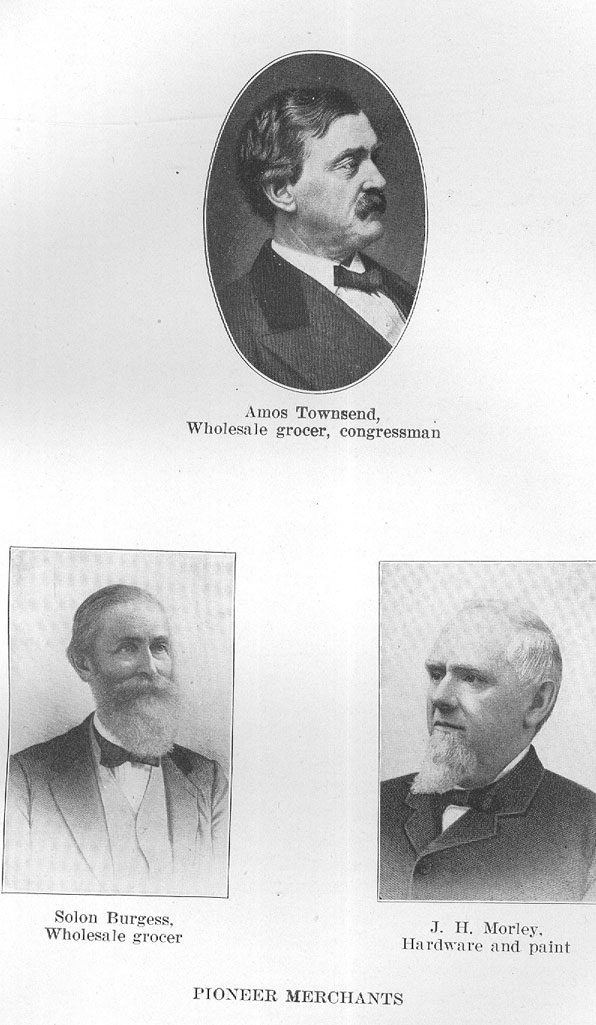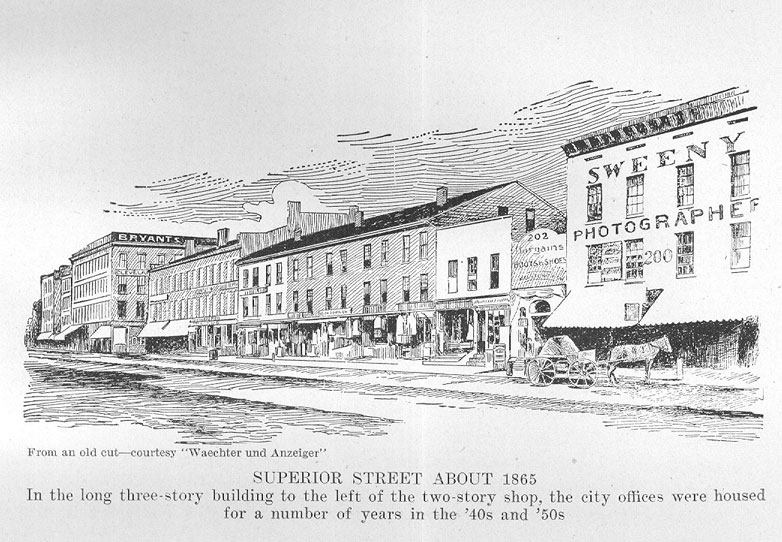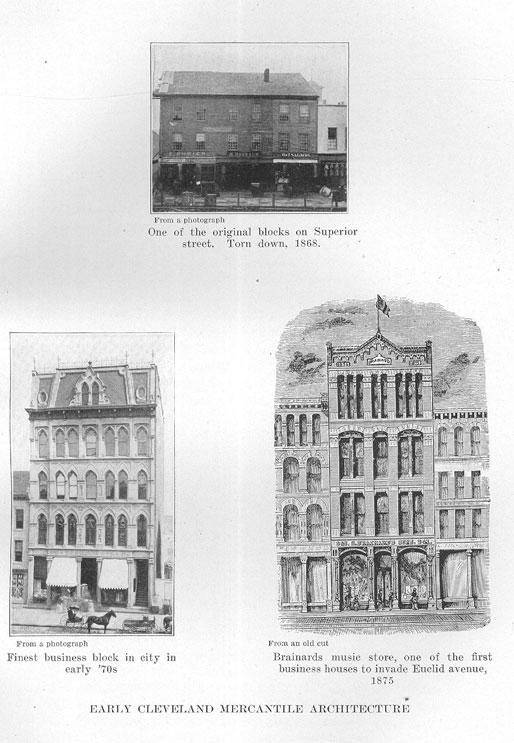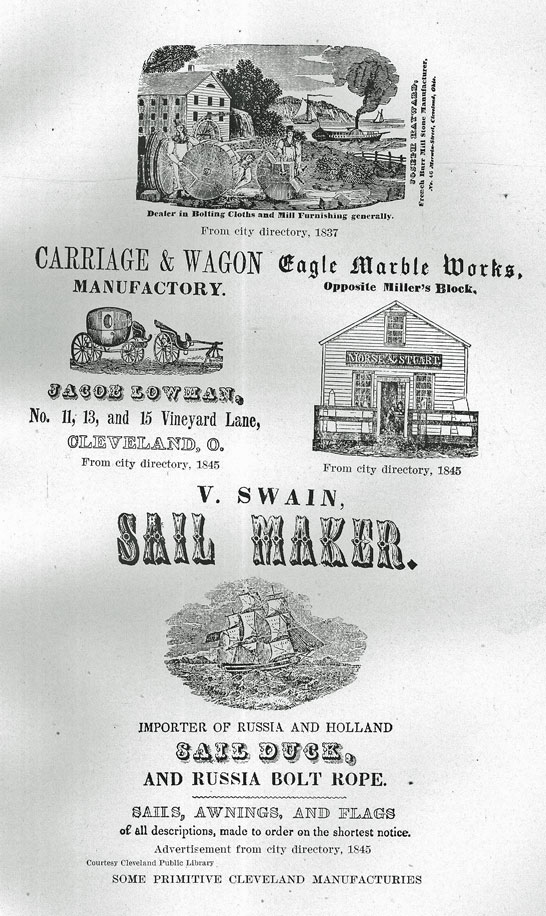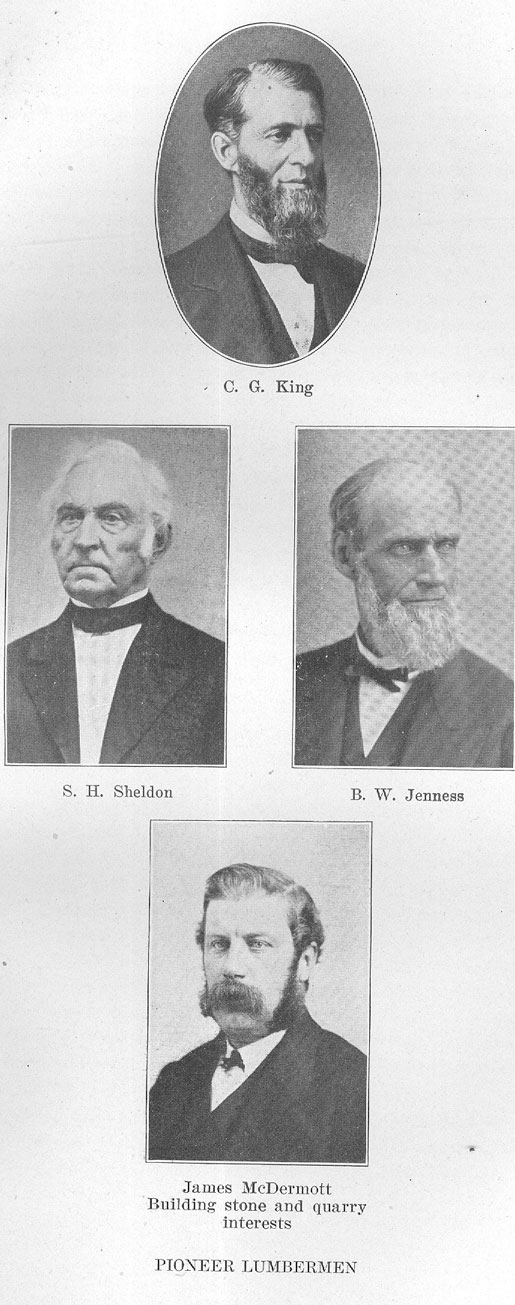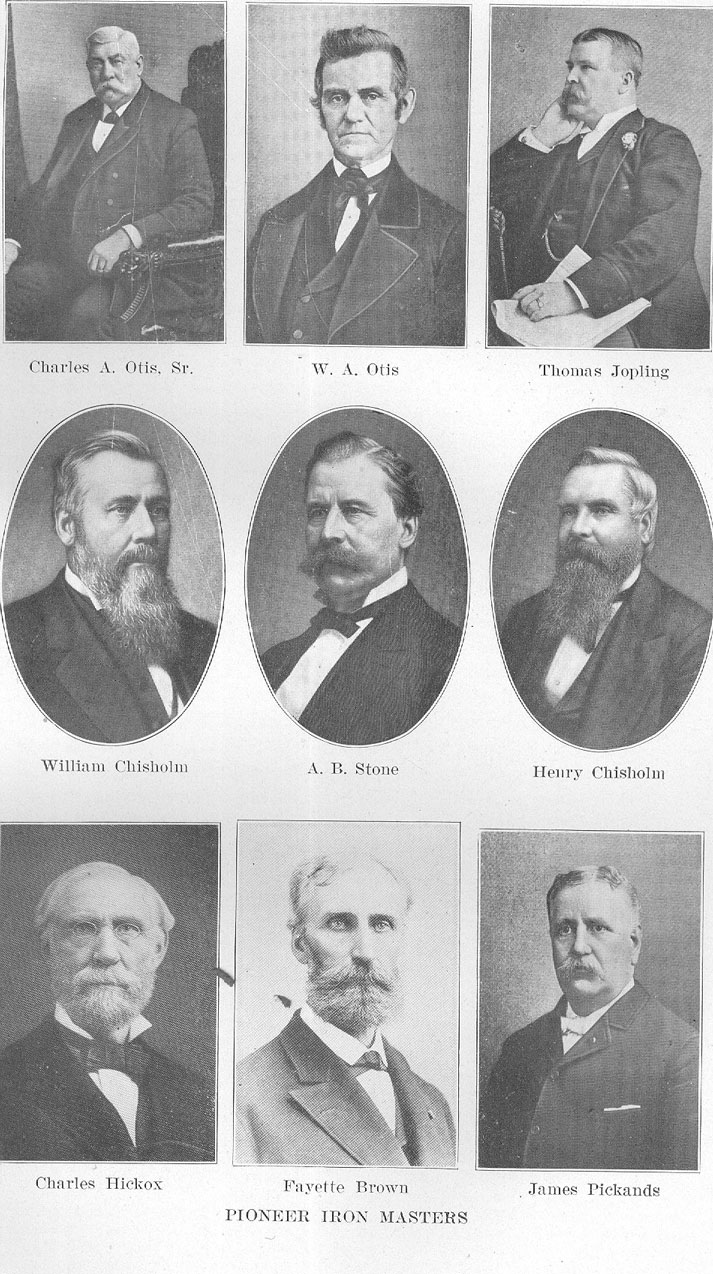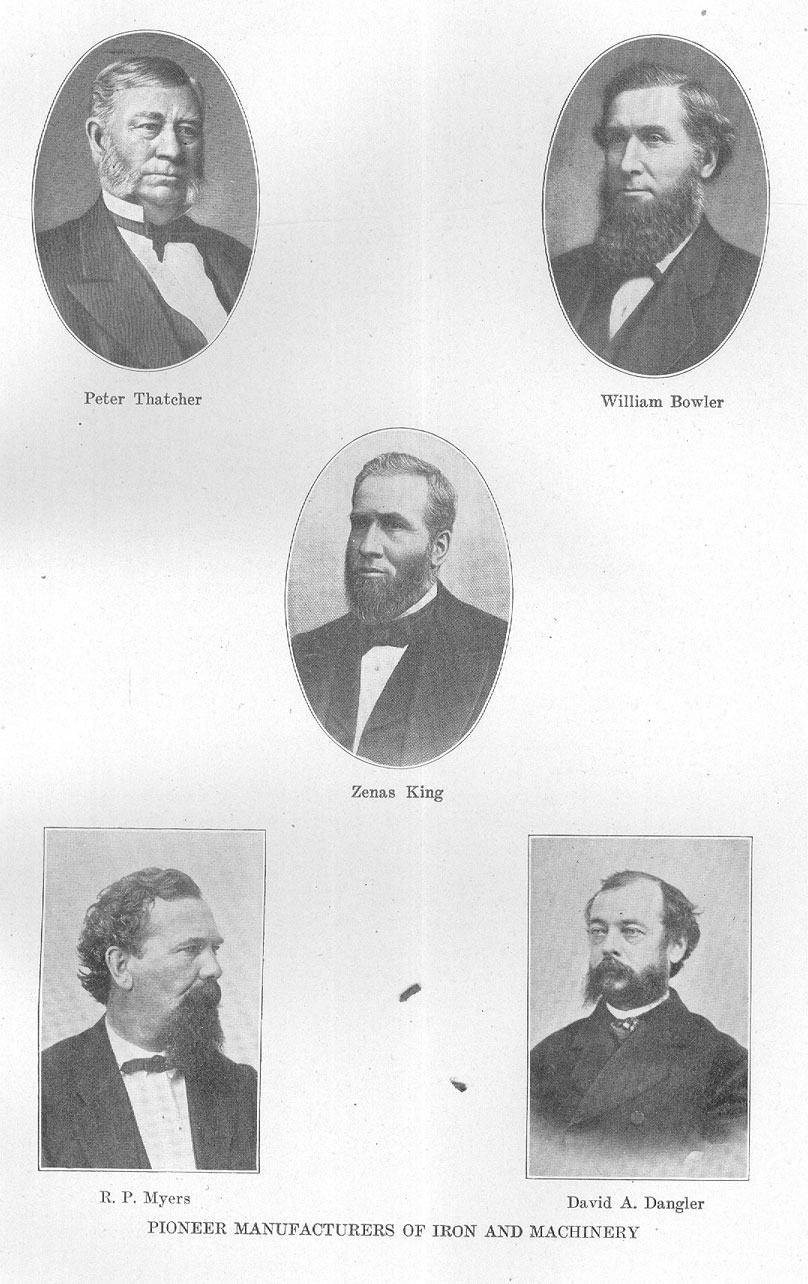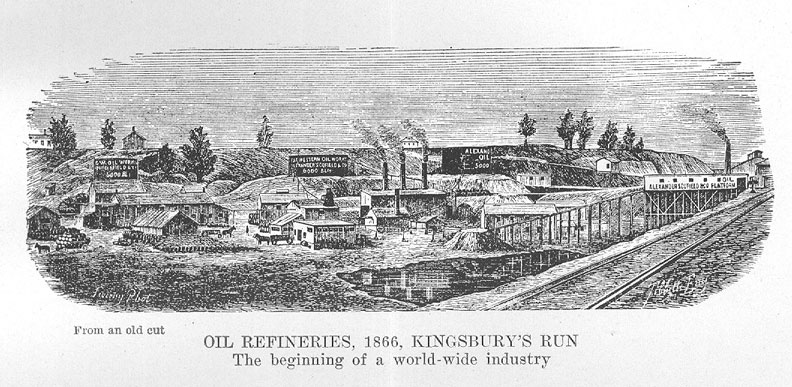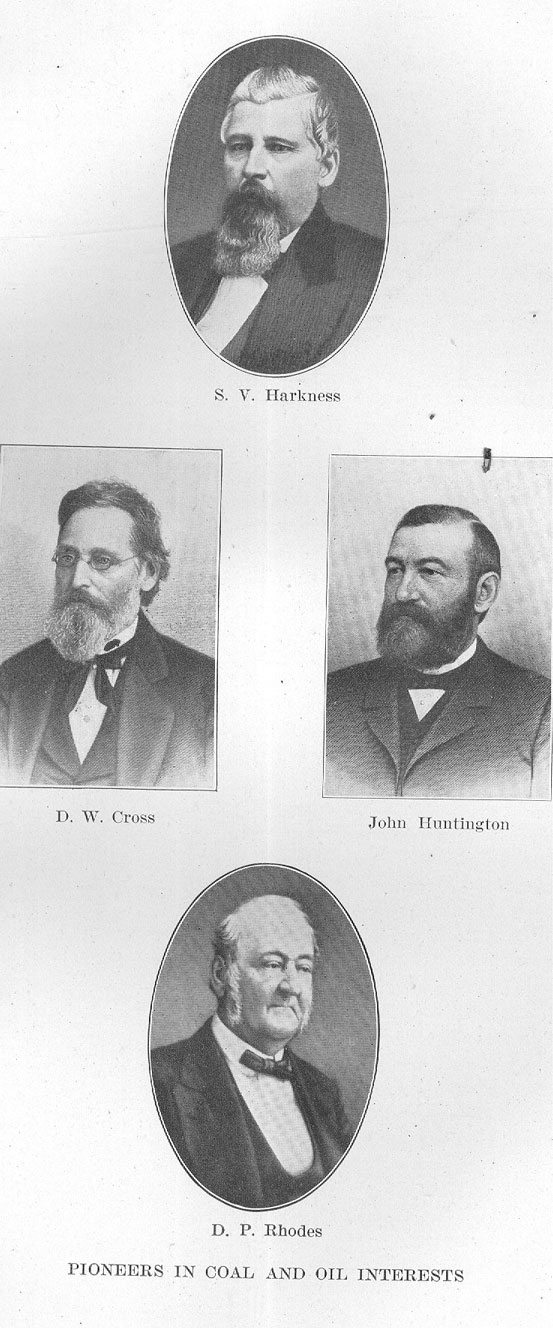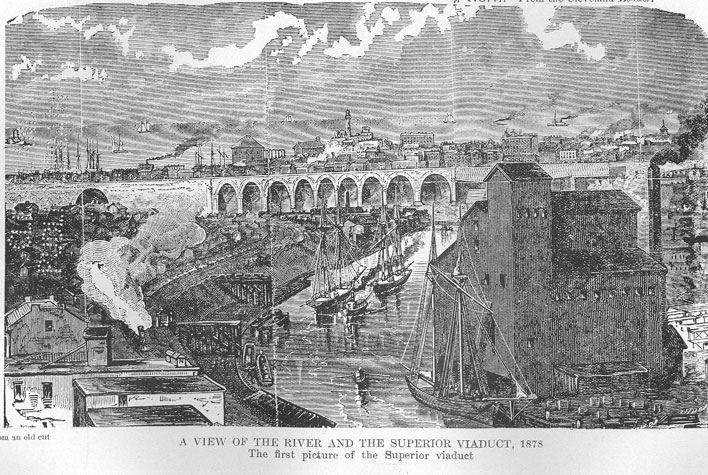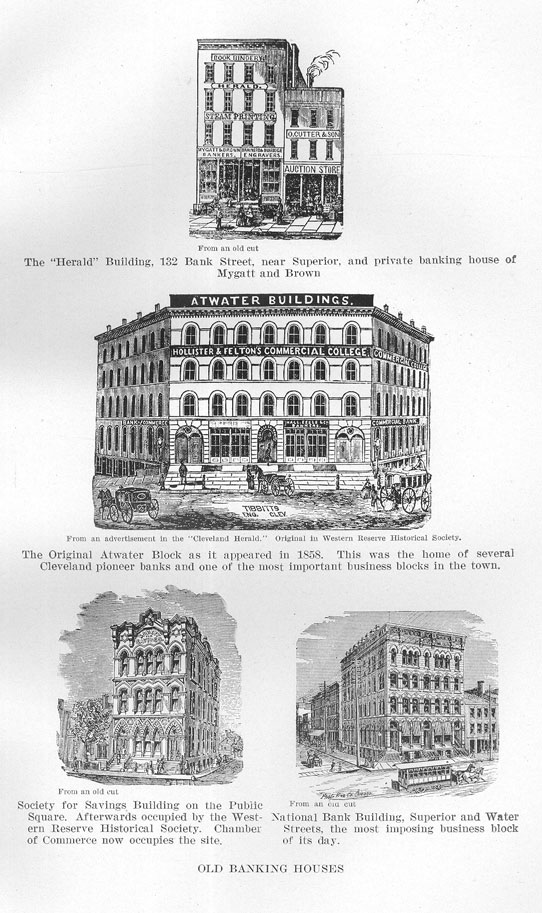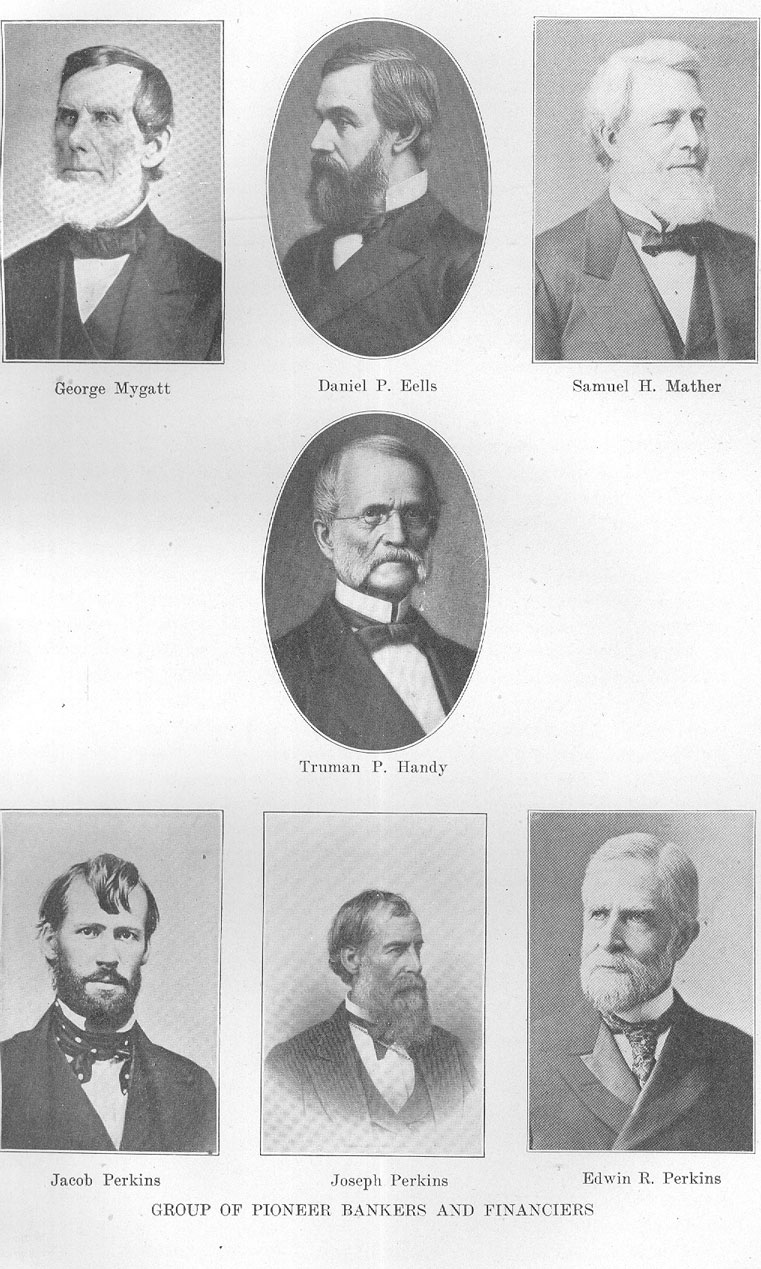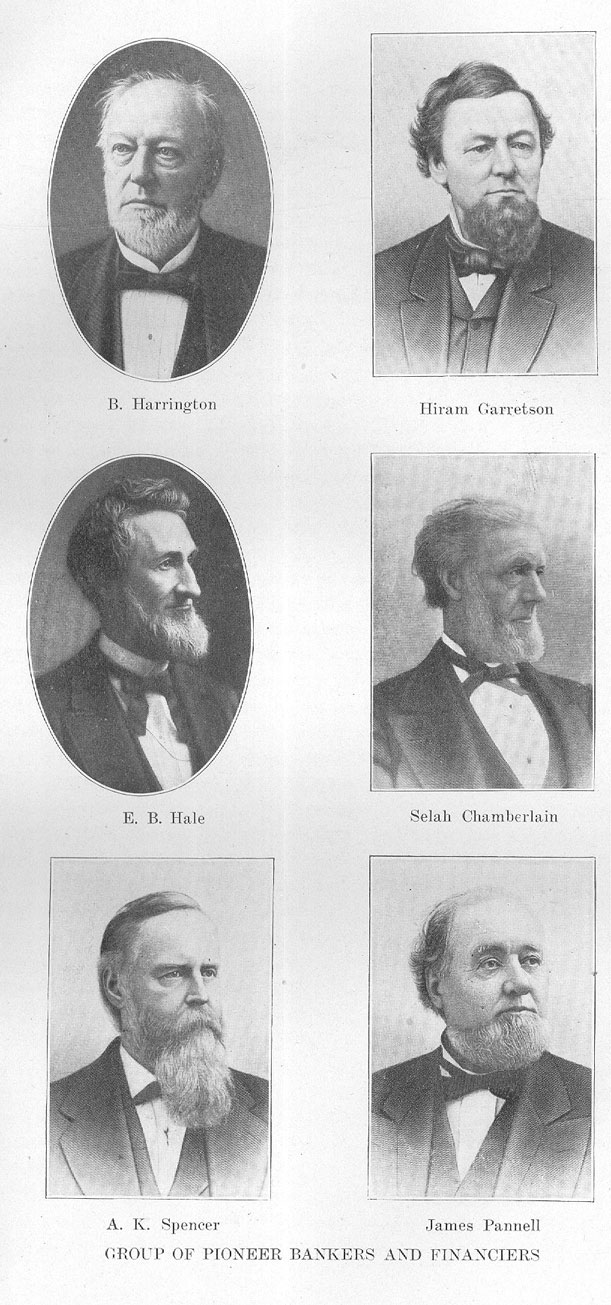600 - HISTORY OF CLEVELAND
Ingham, Mrs. H. M.—Twenty Years' Work in the Woman's Christian Association.
Joblin, Maurice.—Cleveland, Past and Present.
Jones, M. L. tr.—Chiffon's Marriage.
Kaufmann, Wilhelm.—Ein Nordland Fahrt.
Keeler, Miss Harriet L.—Our Native Trees; Our Northern Shrubs; Wild Flowers of Early Spring; High School English (and Adams) ; Studies in English Composition (and Davies).
Kelley, Dr. S. W.—About Children.
Kendall, Ezra F.—Good Gravy; Spots of Wit and Humor ; Tell It to Me; several plays.
Kennedy, James H.—Bench and Bar of Cleveland; Early History of Mormonism; History of City of Cleveland; contributions to Magazine of Western History.
Kirchner, A. R.—(A) Flag for Cuba.
Kiser, S. E.—Ballads of Busy Days; Budd Wilkins at Show, and Other Verses ; Charles the Chauffeur; Georgie; Love Sonnets of an Office Boy; Thrills of a Bellboy.
Klemm, L. R.—Achte Knot.
Knowlton, F. S.—Hawthorne and Lavendar.
Kress, Rev. W. S.—Questions of Socialists and Their Answers. Lawrence, James.—Angel Voices from the Spirit World.
Leggett, M. D.—Dream of a Modest Prophet.
Leonard, Rt. Rev. W. A. (Bishop of Ohio, 1848).—Bedell Lectures ; Faithful Life; History of Christian Church; New York Church Club Lectures; Via Sacra.
Lewis, A. H.—American Patrician; Boss ; Peggy O'Neal; Story of Paul Jones ; Sunset Trail;
Throwback; Wolfville; Wolfville Days; Wolfville Folks ; When Men Grew Tall.
Linscott, Mrs. H. B.—One Hundred Bright Ideas.
Lorenz, Karl.—Scharedmal.
Ludlow, Rev. Arthur C.—History of Cleveland Presbyterianism.
MacHale, Rev. John.—Ballad History of Ireland.
Mackenzie, A. L.—Clarence Milton.
Mcllvaine, Rt. Rev. C. P.—Correspondence with Rev. James Bolles.
McMahon, Rev. William.—Journey with Sun Around the World.
Martin, C. A.—Cana.
Mears, Rev. D. 0.—Sermons.
Metzenbaum, Dr. Myron—Radium.
Michelson, Professor A. A.—Light and Its Uses.
Miller, Mrs. Ellen R.—Nature Stories.
Ming, Rev. J. J.—Data of Modern Ethics Examined; Morality of Modern Socialism.
Moody, Mrs. Helen (Watterson).—Child's Letters to Her Husband; Unquiet Sex.
Morgan, Mrs. Edmund Nash.—Though the Gods and the Years Relent.
Morgan, Rev. T.—Welsh Poems.
HISTORY OF CLEVELAND - 601
Morley, Professor E. W.-Atomic 'Weight of Oxygen; and numerous texts and monograph on chemical subjects.
Morris, R. A.-Washington, Lincoln, etc.
Moxom, Rev. Phillip S.-Aim of Life; From Jerusalem to Nicaea; Religion of Hope.
Mueller, J. E.-Erinnerungen.
Neff, Mrs. Elizabeth Clifford-Anglican Study in Christian Symbolism.
Neff, Mrs. Elizabeth Hyer.-Altars to Mammon; many short stories.
Newberry, A. S.-Caught on the Fly.
Newberry, Dr. John S.-Ohio Geological Survey; United States Geological Survey; many contributions to scientific journals.
Norton, Jessie.—Heartsease.
Ogden, Rollo-Life and Letters of E. L. Godkin; W. H. Prescott ; Maria.
O'Brien, Rev. John-Emerald Isle.
O'Hare, Mrs. Teresa B.-Songs at Twilight.
Olmstead, Millicent—Daffy-Down-Dilly; Land of Never Was.
Orr, Charles-History of Pequot War.
Orth, Samuel P.-Five American Politicians; Centralization of Administration in Ohio; contributions to magazines and legal journals.
Paine, Dorothy—Little Florida Lady; Maid of the Mountains.
Painter, Mrs. J. V.—Chatelaine.
Parsons, Richard—Addresses.
Patteson, Mrs. S. Louise—Complete Manual of Pitmanic Phonography ; Letters from
Pussycatville; Pussy Meow.
Payne, William-Cleveland Illustrated.
Pechin, M. S.-Composition; Anniversary Book of American Revolution.
Peeke, M. B.—Born of Flame; Zenia the Vestal.
Pennington, B. L.-Short Stories.
Pepper, Miss Mary Sefton—Maids and Matrons of New France.
Platner, S. B.—Topography and Monuments of Ancient Rome; Latin Book.
Pratt, Miss Anna M.—Little Rhymes for Little People.
Pounds, J. B.—Hymns, poetry and religious stories.
Proudfoot, John.-Poems.
Rhodes, H. G.-Adventures of Charles Edward; Captain Dieppe; Flight to Eden; Lady and the Ladder ; With Anthony Hope.
Rhodes, J. F.-History of the United States; many contributions to historical journals.
Rice, Harvey.-Founder of City of Cleveland, etc.; Mt. Vernon and Other Poems ; Pioneers of Western Reserve; Incidents of Pioneer Life; Letters from Pacific Slope; Nature and Culture; Sketches of Western Life.
Riddle, A. G.-Ansel's Cave; Hunter of Shagreen; Recollections of War Times; Tory's Daughter; Alice Brand; Bart Ridgley ; Castle Gregory ; House of Ross and Other Tales; Law Students and Lawyers; Life of B. F. Wade; Life of J. A. Garfield; Portrait.
Roberts, E. A.-Official Report of Centennial Celebration of Founding of City of Cleveland.
602 - HISTORY OF CLEVELAND
Robertson, G. A.—History of Bloomfield.
Robinson, J. E.—Philippine Islands.
Robison, W. S.—History of City of Cleveland.
Rose, William.—Tin-Owl Stories, etc.
Rose, Mrs. W. G.—Travels in Europe.
Rosenberg, W. L.—Stuttering.
Ruetenik, H. J.—Erlebnisse.
Ryder, J. F.—Voigtlander and I.
Sandford, S. N.—Historical Sketch of Cleveland Female Seminary. Schauffler, Rev. H. A.—Pastoral Leadership of Sunday School Forces; Teacher, Child and Book; Ways of Working.
Schauffler, R. H.—Christmas; Lincoln's Birthday; Thanksgiving; Through Italy With the Poets; Where Speech Ends.
Schloenbach, J. M.—Land of Fire.
Shackleton, Robert (1860).—Great Adventurer; Many Waters; Quest of the Colonial; Toomey and Others.
Short, R. L.—Algebra.
Sill, Edward Rowland (Cuyahoga Falls, Ohio).—Hermitage and Other Poems ; Poems; Prose (a volume of essays).
Smiley, J. B.—Manual of American Literature.
Snow, Mrs. Jane Elliott—Life of William McKinley; Women of Tennyson. £plan, John—Life With Trotters.
Springer, N. S.—Cloudy Sky.
Staley, Cady—Separate System of Sewerage; Treatise on Surveying.
Stepler, Rev. J.—Feldblumen.
Stevens, B. M.—Story of Women's Work in Cleveland.
Stockwell, Professor J. N.—Eclipse Cycles; Memoir on Secular Variations of Planetary Orbits; Stock and Interest Tables; Theory of Mutual Perturbations of Planets, etc.
Stratton, Mrs. J. M.—Cecil's Crown; Kitty's Jewels.
Streator, Dr. M. L.—Pyramids.
Street, Mrs. T. E.—To the April Baby.
Stroup, Rev. N.—Text Book on Theology.
Swasey, Ambrose.—New Process for Generating; Generating and Mechanical Science.
Sweetser, Delight.—One Way Around the World.
Taylor, B. F.—Summer Savory, etc.; Old Time Pictures, etc.; Between the Gates ; November Days; January and June; Poetical Works; Mission Ridge and Lookout Mountain; Pictures of Life in Camp and Field ; Songs of Yesterday; Theophilus Trent; World on Wheels and Other Sketches.
Thompson, Miss Adele E.—Beck's Fortune; Betty Seldon, Patriot; Brave Heart Elizabeth; Lassie of the Isles ; Polly of the Pines.
Thompson, 'A. H.—Examiner's Companion.
Thorndike, A. H.—Elements of Rhetoric and Composition.
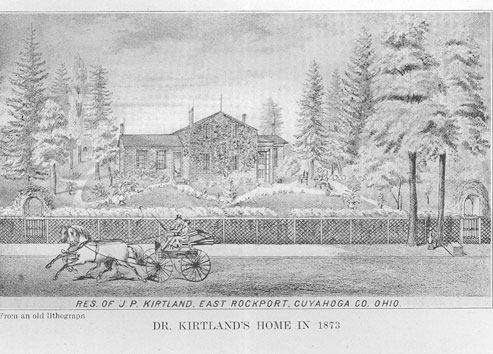
HISTORY OF CLEVELAND - 603
Thwing, President Chas. F.-American Colleges—Their Students and Work; The Reading of Books ; The Family (with Mrs. Thwing) ; The Working Church ; Within College Walls; The College Woman ; The American College in American Life; The Best Life; College Administration; The Youth's Cream of Life ; God in His World ; If I were a College Student; The Choice of a College; A Liberal Education and A Liberal Faith ; College Training and the Business Man ; A History of Higher Education in America; contributions to magazines.
Tower, O. F.-Chemical Analysis of Iron.
Townsend, E. W.-Beaver Creek Farm; Chimmie Fadden and Major Max; Daughter of the
Tenements ; Near a Whole City Full ; Days Like These; Our Constitution; Reuben Larkmead ; Seeds and Season ; Summer in New York.
Trimble, George.—Lake Pilots.
Upson, Dr. H. S.—Insomnia and Nerve Strain.
Urann, Miss Clara A.-Centennial History of Cleveland.
VanHorn, F. R.-Mineralogy.
Wallace, F. T.-Nuggets ; Experiences of a Forty-niner; Men and Events of Half a Century.
Walters, Eugene, playwright.—Paid in Full, etc.
Ward, M. A.—Life of Dante ; Old Colony Day; Petrarch ; People of Nineteenth Century.
Weseloh, Henry.—Gott in der Natur.
West, T. D.-American Foundry Practise; Metallurgy of Cast Iron ; Moulder's Text-Book.
Whitney, H. H.-Some Verses.
Whittlesey, Charles.—Early History of Cleveland ; Smithsonian contributions; many contributions to scientific and historical journals ; many tracts, Western Reserve Historical Society ; for list of writings see Tract 68, Western Reserve Historical Society.
Wilcox, Delos F.-American City ; Municipal Government in Michigan and Ohio ; Study of City Government ; Ethical Marriages.
Williams, Right Rev. C. D. (Bishop of Michigan).—Valid Christianity for Today.
Wilson, Mrs. S. S.—Ohio.
Wolfenstein, Martha.-Idylls of Grass.
Woolsey, Sarah (Susan Collidge).-"What Katy Did" series and many juvenile stories ; Few More Verses ; Old Convent School in Paris ; History of City of Philadelphia ; Rhymes and Ballads for Girls and Boys.
Worthington, Rev. E. W.—Devotional Introduction ; Ember Days.
Woolson, Constance Fenimore.-Anne; Castle Nowhere; Dorothy and Other Italian Stories ; East Angels ; Horace Chase ; Jupiter Lights ; Mentone, Cairo and Corfu; Transplanted Boy.
Wright, E. S.-Westward Around the World.
Wylie, Edna E.—Blue Valley Feud ; Little Dream Playmate ; Refining of Mary Ann; Theodor's Stepmother ; Ward of Sewing Circle ; Will of Caxton's.
Zerbe, Ida.-Pius from Plaisance.
Zorn, C. M.-Auf den Weg.
604 - HISTORY OF CLEVELAND
CHAPTER LXIII.
SOME CLEVELAND SCIENTISTS.
There have been some notable contributions to science and some important inventions made by Cleveland men.
The first scientific association in Cleveland was the Cleveland Academy of Natural Science, organized in 1845 at the suggestion of Dr. Kirtland. The first meeting was held November 24, 1845, when Dr. Kirtland was elected president; Sherlock J. Andrews, first vice president ; Charles W. Heard, second vice president ; William D. Beattie, third vice president. The curators were William Case, Hamilton L. Smith, Samuel St. John, Henry C. Kingsley, Rufus K. Winslow, Jared P. Kirtland, J. Lang Cassells, Charles Whittlesey. A creditable collection of geological, zoological and botanical specimens was gathered, which was at first stored in the Medical College, where the Academy met. For a number of years during the winter public lectures were given by members of the Academy. Among the many published contributions to science made by the members may be mentioned : "Description of New Varieties of Fish"; "The Classification of Diurnal lepidoptera of Northern and Middle Ohio"; "Classification of Fossil Coal Plants," by Dr. Newberry ; "A Description of the Mosses Found in the Vicinity of Cleveland," by Professor Cassells ; numerous observations of fishes, by Dr. Garlick; studies among the coal measures and the drift, by Dr. Newberry ; a description of the mounted birds in the museum, by Dr. Kirtland. It was reorganized in 1869 into the Kirtland Society of Natural Science, which in 1870 became identified with the Cleveland Library Association. A few years later its collections were given to Case School of Applied Science.
Connected with these early societies are the names of four men, who were pioneers in scientific work. The first of these is Dr. Jared P. Kirtland, a distinguished naturalist, teacher and physician. He was born in Wallingford, Connecticut, in 1795, and came to Poland, Trumbull county, on horseback, when he was fifteen years old. His father was the general agent of the Connecticut Land Company at that place. After studying medicine in Dr. Rush's noted school in Philadelphia, he practiced in Trumbull county for nearly twenty years and was several times elected to the legislature. In 1838 he was appointed naturalist of the first Ohio geological survey. He lectured one year in the Cincinnati Medical College and at the close 0f the year 1838, accepted a professorship in the newly organized Cleveland Medical College. Soon thereafter he bought an estate near Rocky river and this became a noted experimental farm, where were originated many new varieties of fruits, including several varieties of cherries and the well known Kirtland strawberry. Here the aged naturalist had a remarkable collection of trees and shrubs, and his flower garden was known throughout the state. Dr. Kirtland also made important discoveries in zoology, His first original contribution to science was on the classification of fresh water mollusks, while he was still a young physician in Poland. From his farm the doctor drove daily to his classes in the city until within a few years before his death, which occurred December 10, 1877. Tradi-
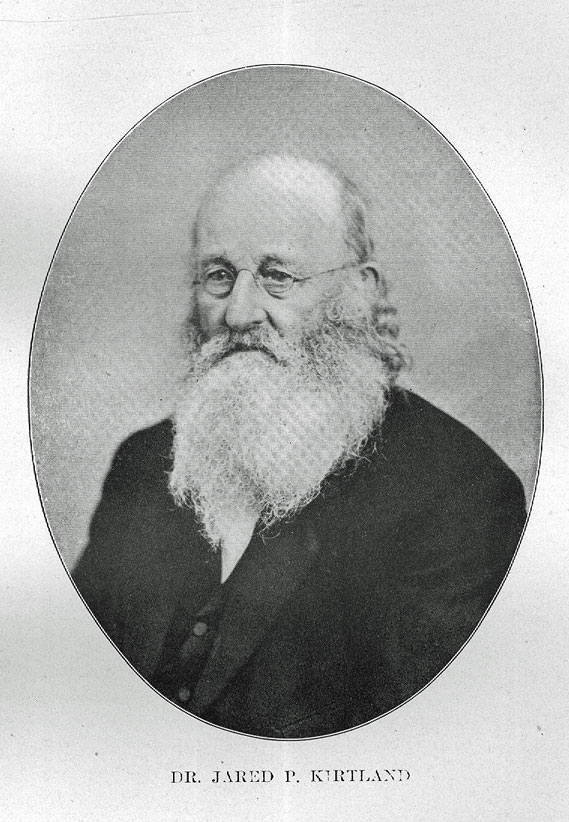
HISTORY OF CLEVELAND - 605
tion has handed down many beautiful and quaint stories concerning his simple habits and delightful personality.
Dr. Theodore Datus Garlick was another of the early group of Cleveland's sciensists, who founded the Academy of Natural Science. He was born in Middlebury, Vermont, March 30, 18̊5, came to Cleveland in 1819, was engaged for a time as a stone cutter, became a physician, practicing for some years in Youngstown, and returning to Cleveland in 1853 to practice medicine. He was an authority on the artificial propagation of fish and his book published on that subject in 1854, remained the standard for many years. He urged upon the government the artificial propagation of brook trout and other fish, but met with rude rebuff and brutal treatment from government officials. He was also a widely known botanist, and possessed great skill as a modeler in clay, his anatomical models being widely used. In the collections of the Historical Society are a number of specimens of his handicraft, among them a bust of his devoted friend, Dr. Kirtland.
Another of this distinguished group and the one most widely known for his original contributions to science was Dr. J. S. Newberry. He was born in Cuyahoga Falls, graduated from Western Reserve college in 1846, and from the Cleveland Medical college in 1848. He practiced medicine but a few years. He was appointed assistant surgeon and geologist of t party sent by the war department in 1855 to explore the regions between the Columbia river and the Pacific ocean. This was the beginning of a brilliant scientific career. He became state geologist of Ohio and of the United States geological survey and professor of geology in the School of Mines in Columbia university. His studies covered every phase of geological research, but he will be longest remembered for his work in paleontology.
The fourth member of this interesting group was Col. Charles C. Whittlesey. He was a geologist, mining engineer and archaeologist of great distinction. He was born in 1898, lived in Cleveland nearly all his life and died here in 1886. His little white cottage on Euclid avenue, near the present East 65th street, surrounded by clusters of choice shrubs, will be remembered by the older members of the community. He was a member of the first geological survey of Ohio, a pioneer in American archeology, and a civil engineer of many achievements. He was likewise the historian of our early Cleveland life, a writer of many tracts in the Historical Society series, and a voluminous contributor to scientific journals, including the Smithsonian Contributions, and founder of the Cleveland Academy of Natural Science, the Kirtland Society of Natural History, and the Western Reserve Historical Society.
To this group may be added the name of Dr. Elisha Sterling, who was born in New York state August 15, 1825, and died in Cleveland December 29, 189o. He came to Cleveland in 1827, graduated from the Cleveland Medical College, studied in Paris, where his skill attracted attention. He traveled over the continent, going over twenty-five hundred miles on foot studying natural science, and observing the people, their customs and manners. Through the friendship of Dr. Newberry, Dr. Sterling was appointed naturalist of the government expedition to California and Oregon. He was an adept taxidermist, an expert on fish culture, a contributor to scientific journals, one of the founders of the Kirtland Society,
606 - HISTORY OF CLEVELAND
and an "Arkite." He gained eminence in surgery, and was one of the cultured public-spirited men of his generation.
Dr. John Lang Cassels was prominent in scientific work, and associated with Dr. Kirtland on the faculty of the Medical College in 1843. He was professor of chemistry, and did pioneer work in the mineralogy of the Lake Superior mineral regions, which he visited in 1846. He made the journey to the interior of the peninsula by canoe under the guidance of an Indian. His prophecies concerning the riches of that region were received with smiles, but many Clevelanders reaped a golden harvest from his pioneer work.
The later scientific work done in our city has centered about the laboratories of Case School of Applied Science and Western Reserve University. Among the distinguished scientists of America, Professor William E. Morley takes first rank as a chemist. Professor Morley was born in Newark, New Jersey, in 1838, became professor of chemistry in Western Reserve College at Hudson in 1869, and when that institution was moved to Cleveland became also professor of chemistry in the Medical College. In 1906 he resigned these positions and moved to West Hartford, Connecticut, wherhe is engaged in research work. Professor Morley's special research was in determining the atomic weight of oxygen, and his work on that subject was published by the Smithsonian institution in 1895. Professor Morley has conducted many other notable researches, is a member of the learned societies of America and Europe, and an extensive contributor to scientific journals, and has been decorated by several European societies. Associated with him for many years was Professor Michelson, the distinguished physicist, who was professor of physics in Case School of Applied Science from 1883 to 1889, and is now a member of the faculty of the University of Chicago. These two distinguished scholars conducted researches in light and other subjects of physical science.
Professor C. F. Mabery, professor of chemistry in Case School, has for many years been prominent as an investigator in the composition of petroleum and the constituents of lubricating oils.
Professor Dayton C. Miller, professor of physics in Cast School, has conducted notable experiments in the nature of sound and sound waves and other important work in experimental physics.
Cleveland being the center of great manufacturing interests, there have been a number of scientific discoveries of a practical nature. The Cowles brothers in 1884 laid the foundation for electric smelting. A good deal of practical work has also been done in the chemistry of steel and steel castings. Of mechanical inventions, there have been great multitudes. The most renowned invention made in Cleveland was that of the electric arc light by Charles F. Brush in 1876. Mr Brush was born at Euclid, Ohio, March 7, 1849, and graduated from the Engineering Department of the University of Michigan in 1869. He was the founder of the Brush Electric Company, has made many inventions for the practical application of electricity to the needs of society, was decorated by the French government in 1881 for achievements in electrical science, and in 1899 received the Rumford medal.
Many scientific instruments of great interest and importance have been made in the manufactory of Warner & Swasey. Both members of this firm are dis-
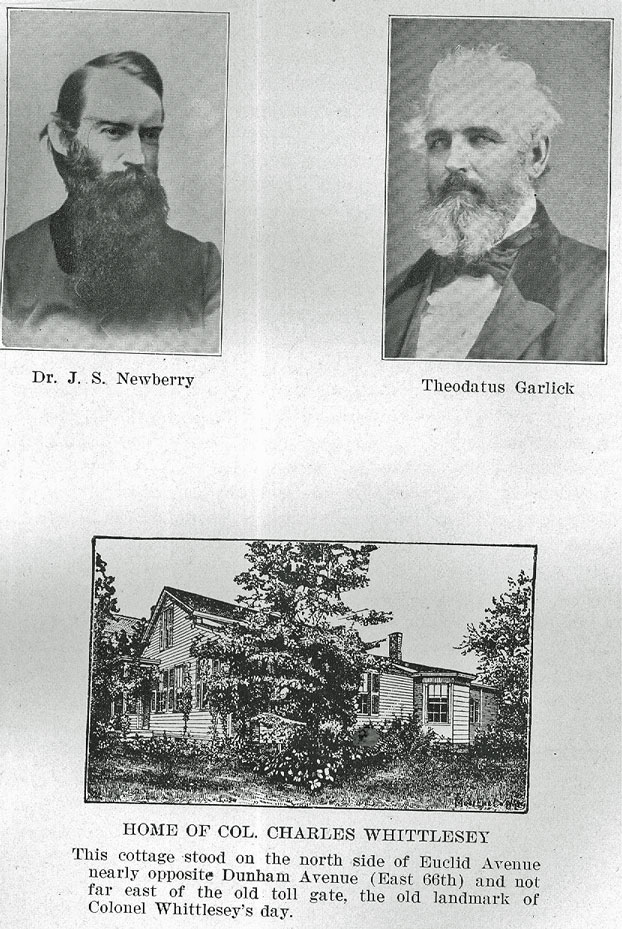
HISTORY OF CLEVELAND - 607
tinguished for their scientific work. They excel in all branches of telescope building and the making of instruments of precision, including range finders, gun sights, field telescopes, etc. Among others of their notable achievements, must be included the building of the thirty-six inch Lick telescope, the twenty-six inch telescope of the Naval Observatory at Washington, and the forty inch telescope of the Yerkes Observatory for Chicago University. Many new inventions have been recorded by both Mr. Warner and Mr. Swasey. This fortunate partnership was entered into in 1880.
William Chisholm, Sr., has contributed a long list of successful industrial inventions. Mr. Chisholm was born in Scotland, August 12, 1835, came to Cleveland in 1852, became manager for the Cleveland Rolling Mills, and invented many processes for the manufacture of Bessemer steel into screws, spades, etc., and devised new steam hoisting and pumping engines and conveying machinery.
Alexander E. Brown has secured several hundred patents on hoisting machinery. He is president of the Brown Hoisting Machine Company, is a distinguished engineer, a member of the learned engineering societies of America and Europe and a writer upon technical subjects. The machinery made in his establishment is used in every part of the world.
Cady Staley, president of Case School of Applied Science from 1886 to 1902, was one of the engineers in the building of the Central Pacific Railroad and is the author of several works on engineering. He was born December 12, 1840, near Minaville, New York, and graduated from Union college in 1865.
Two astronomers of distinction must be mentioned, Professor Charles S. Howe and Professor John N. Stockwell. Professor Howe, before becoming president of Case School of Applied Science, was professor of astronomy in that institution. He has contributed to astronomical and mathematical journals, has presided over several of the learned societies, and is a leader in the movement for industrial and technical education in America. Since he has been president of Case School of Applied Science he has been compelled to give up a great deal of his active scientific work.
Professor John N. Stockwell was born in Northampton, Massachusetts, April 10, 1832. He came to Brecksville in his youth and good fortune led him into an acquaintanceship with William Case. Their mutual love for astronomy and mathematics soon ripened the acquaintance into intimacy. Professor Stockwell secured the proper instruments for observation and began a series of original investigations that rank him among the foremost astronomers of the times. He is the author of many works on astronomy, a contributor to the American and foreign scientific journals and to the Smithsonian Contributions.
DIVISION IX.
FINANCIAL AND COMMERCIAL.
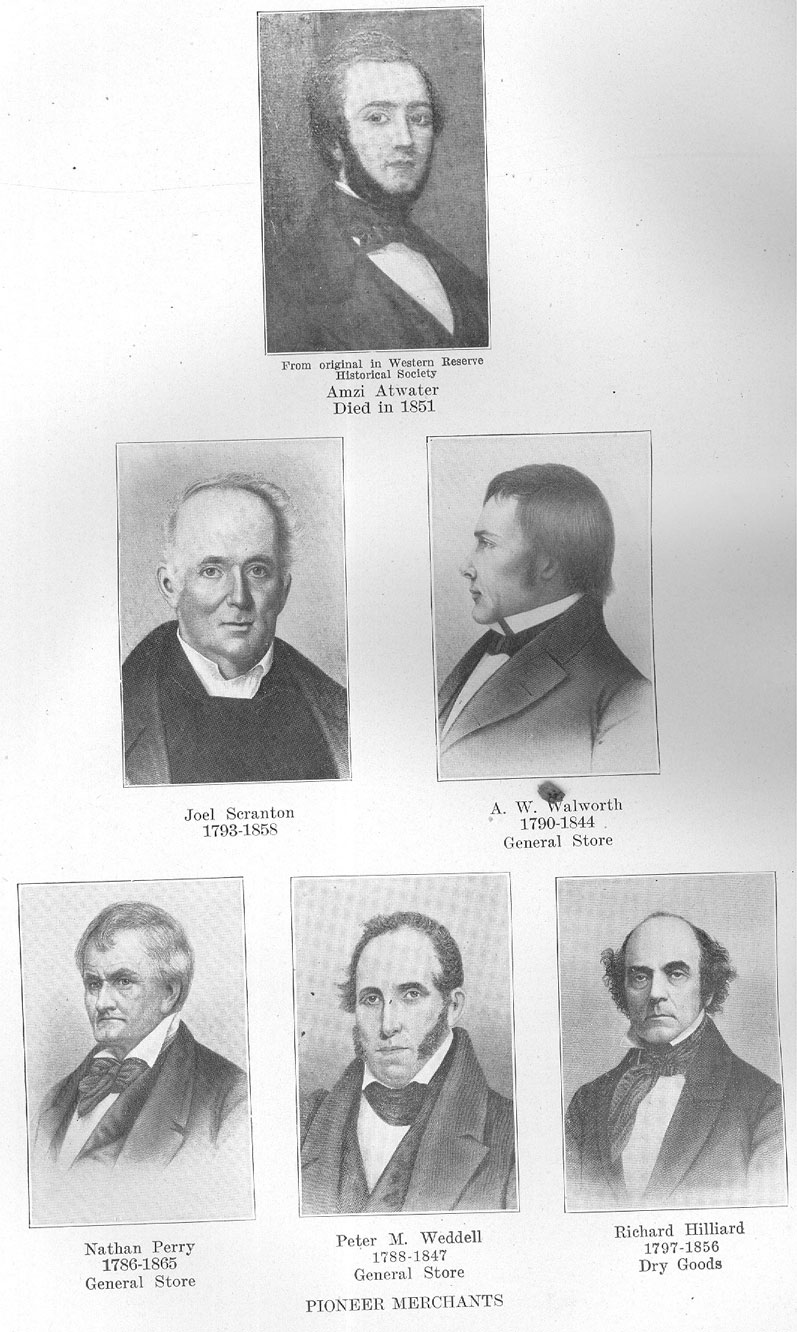
CHAPTER LXIV.
EARLY TRADE AND MERCANTILE DEVELOPMENT—THE
GROWTH OF THE CITY.
A small log hut, as headquarters, was built by the traders in 1786, near the spring at the foot of Main street. (1) Harvey Rice states that "In 1797 Edward Paine opened the first dry goods store in Cleveland." (2) The straggling population of the village needed but few supplies. Judge Barr leaves a picture of mercantile Cleveland in 1803: "Bryant's log distillery, of course, attracted the attention of such Senecas, Hurons, Chippewas and Delawares as had a weakness for firewater. Alexander Campbell, who was doubtless a Scotchman, saw that here was a good place to traffic with the stoics of the woods. He built a rude store a little further up the hill near the spring but more toward the junction of Union and Mandrake lanes. * * * In this cluster of log shanties, the principal traffic of Cleveland was transacted. Here the red men became supremely happy over a very small quantity of raw whiskey, for which he paid the proceeds of many a hunt. If anything remained of his stock of skins after paying for his whiskey, the beads, ribbons and trinkets of Mr. Campbell's store absorbed the entire stock. Here squaws bartered and coquetted with the trader, who in their eyes was the most important personage in the country. Here the wild hunter in his dirty blanket made the woods ring with his savage howls, when exhilarated with drink. He shone forth for a moment in his native barbarity, ferocious alike against friend and foe." (3)
"Previous to the war, the principal business on the lakes was the transportation of salt and furs In 1811 one hundred and twenty thousand dollars worth of the latter was taken by Captain Dobbins in the schooner "Salina," from Mackinaw ; eighteen thousand barrels destined for the Pittsburg market arrived at Erie in a single season. Flour, pork, whiskey, high wines, intended
1 - Whittlesey's "Early History," p. 365.
2 - "Pioneers of Western Reserve," p. 61.
3 - Whittlesey's "Early History of Cleveland," p. 390.
612 - HISTORY OF CLEVELAND
for the Indian trade, and the markets of Detroit and Mackinaw, came from Pittsburg and served as an offset to the fur trade of the former. From 1796 to 1802, what few emigrants and merchandise found their way into Ohio from the Atlantic settlements were conveyed hither mostly by Schenectady boats, following the routes of the original surveys. From 1802 to 1812, goods were brought from Albany'to Black Rock by wagons; the merchants starting to New York in July. These goods were frequently detained on the way until the spring of the ensuing year." (4)
In 1808 Nathan Perry, whom Judge Griswold called "Cleveland's first great merchant," joined the group of traders and built a store and dwelling on the corner of Superior and Water streets. Within a decade he supplanted this with a brick building, the third brick building in Cleveland, where he carried on an extensive business. Nathan Perry possessed the genius of a trader. He had learned the dialects of the Indians and made the foundation of his fortune in fur trading. Perry was the first merchant in northern Ohio to do more than supply the scant local needs of his community. His mercantile enterprises extended over the Reserve and he soon became a rich man, investing his funds in real estate and leaving one of the largest estates in the city. He died June 24, 1865. Perry street was named for him.
In 1810 Harvey and Elias Murray built a frame store on Superior street near the Forest City block, and occupied it until Hull's surrender of Detroit, when it was used as a hospital for the soldiers. After the war it was again 'sect for mercantile purposes. In 1855 it was torn down.
In 1809 Major Carter built a log warehouse near Union lane and in 1811 Elie Murrays built one near the mouth of the river. These served for storing the merchandise that was brought by schooner on the lake from Buffalo, or by laborious teams in "Pennsylvania wagons" or by packhorse, from Philadelphia to Pittsburg, thence to Cleveland.
In 1814, J. A. and Irad Kelley built the first brick building in the town, a store on Superior street. In 1815 Noble H. Merwin' came to Cleveland and built a log warehouse on the corner of Superior and Merwin streets. The next year he brought his family from Connecticut and purchased the "tavern stand" of George Wallace on the corner of Superior street and Vineyard lane. His house was known as "Merwin's tavern" and later as the "Mansion House." Merwin became one of the leading business men of the village, engaging in the provision trade and in forwarding. James Kingsbury kept a store in 1816. In 1817 the first frame warehouse was built by Leonard Case and Captain William Gaylord on the river north of St. Clair street. This was soon followed by one built by Dr. David Long and Levi Johnson, and still a third by John Blair. These latter were both below Gaylord's.
In 1818 Orlando Cutter arrived with twenty thousand dollars worth of merchandise, an enormous stock for those days. He sold it the following year to Merrit Seeley. In 182o Peter M. Weddell establish a mercantile business here that developed into one of the largest in northern Ohio.
In 1821 mercantile Cleveland clustered around "Perry's Corners," Superior and Water street, where stood Perry's "little white store" and the Kelleys'
4 - "National Magazine," December, 1845.
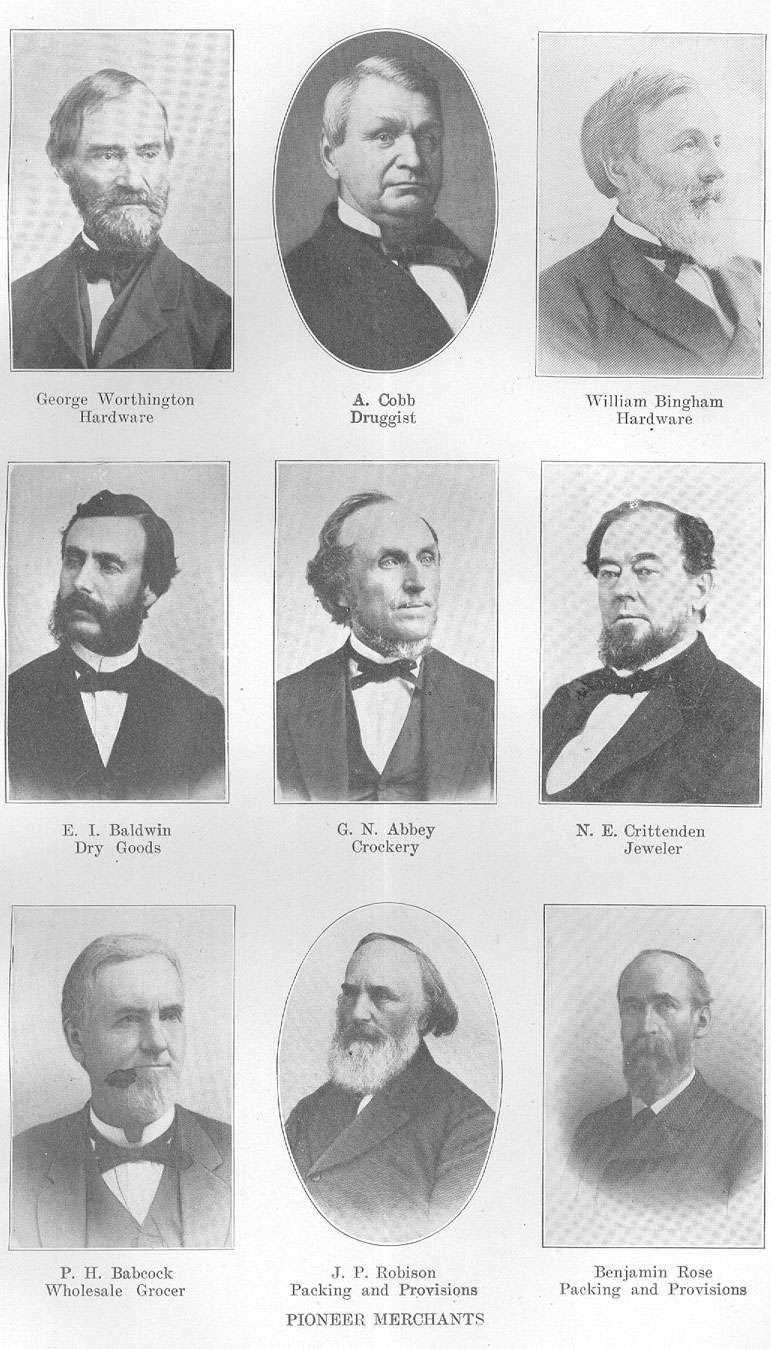
HISTORY OF CLEVELAND - 613
"big brick store," also Major Carter's "red tavern," built of logs and veneered with clapboards. In the marshes on the river were the scattered warehouses, small log or frame buildings. Those wishing to cross to the west side were ferried over from the foot of Superior street by "old Uncle Kit Gunn," in a primitive flat boat. Where the Weddell House later stood, "Uncle" Abraham Hickox had his blacksmith shop, with its noted sign "Uncle Abraham works here." From his shop to the lake was pasture land, enclosed with an old worm rail fence. The flats were a tangle of grape vines and forest, affording good hunting. From Erie street to "Doan's Corners" was woods. Curtis' tannery stood where A. P. Winslow later built his splendid home (Giddings avenue). On Erie street there was a clearing of about four acres, enclosed by a rail fence. A log house stood where the Cleveland Trust building now stands. From there to the Square which was "covered with bushes and stumps," there were no houses. (5)
In 1825, with a population of about five hundred, Cleveland began its real growth with the opening of the Ohio canal. With this development of population came a great many mercantile enterprises. The first city directory, 1837, when the town had about five thousand population, gives an opportunity for analyzing the occupations and industries of the city. There were seventy-one grocery stores, twenty-five dry goods and clothing stores, seven millinery stores, five hardware stores, four boot and shoe stores, supplying the town and its outlying farms. These were all small stores, confining their trade to one line of goods, excepting a few, which had combinations of "dry goods and hardware," "dry goods and groceries," "dry goods and shoes." Several wholesale grocers and wholesale dry goods stores had begun the distributing business which within fifty years developed into large proportions. Twenty-five forwarding and commission merchants indicate the principal mercantile industry of the town. The lone log warehouse of Carter had multiplied many fold with the advent of canal and steamboat. Ship chandlery also began to be a leading industry. The retail business was confined to lower Superior street, Water street, River street, with a few grocery stores and some millinery and tailor shops on St. Clair, Pittsburg, Prospect and Michigan streets. North of Superior street was the fine residence portion of the town. The wholesale and warehouse business was confined to River street and the wharf district.
This was still the day of the artisan. Here are some of the trades enumerated in the first Directory : sawyer, lath joiner, coach maker, agriculturist, laundress, joiner, millwright, shingle maker, turner, soap boiler, fancy dyer, hair dresser, watchmaker and jeweler, draper and tailor, tailoress, drover, house mover, upholsterer, rope maker, tallow chandler, chair maker, coach and gig trimmer, peddler, carter, hosier, shoemakers and locksmith. This catalogue of homely industries indicates a village that has not yet been turned over to the machine age.
BARTER AND TRADE.
In those years trade was by barter, money was- scarce, and bank notes were of dubious value. Whiskey made in the rude distilleries, of the corn grown
6 - See "Annals Early Settlers Association," No. 9, P. 34.
614 - HISTORY OF CLEVELAND
among the stumps passed as a medium of exchange at twenty cents the gallon in 182o. "In 1817-18, small change was very scarce, and the trustees of the village, to relieve the wants of the people, after consulting with the business men, concluded best to issue corporation scrip, called by the people 'Corporation Shinplasters,' to the amount of one hundred dollars, in denominations from six and a quarter cents to fifty cents. * * * A silver dollar was divided into nine pieces, each passing for a shilling, and a pistareen, worth eighteen and three-quarter cents, went for a shilling also." (6)
In 1818 Leonard Case advertised ninety acres for sale in Warrensville "which he will sell cheap for cash and salt, flour, whiskey, wheat or rye." (7) In the same issue a merchant advertises that highest prices will be paid for oats "in salt or cash." In 1819 Nathan Perry announces his new brick store and that "he will receive in payment furs, pot and pearl ashes and good clean rye. * * * N. B. He wishes to purchase a quantity of pork, for which he will give five dollars per hundred for hogs weighing one hundred and eighty and upward, part of which will be paid in cash ; a libe'ral discount will be made on goods for eastern money." (8) A competitor, E. Taylor, in the same issue says he will receive in payment for goods purchased "pork, whiskey, rye, corn, tallow, butter and some first quality flour."
Another merchant has, "Now landing from the schooner Neptune three hundred barrels salt to be sold for cash or most kinds of country produce," and others advertise for cattle "for which they will pay a liberal price, either in salt or goods, or in what is termed money in the state of Ohio." (9) Hubbard & Parson, "tin and sheet iron manufactory" let it be known that "all articles commonly taken at eastern factories, will be received in*payment at a fair price : as rags, pewter, brass, copper, feathers, bristles, beeswax, furs, ginseng, dried peaches and apples, cash, etc." (10) This seems an omnibus provision. Even the ladies were privileged to barter. In 1827 Mrs. Coolidge opened a millinery store opposite the Franklin House. "She has on hand an assortment of hats, caps, head dresses, etc., of the latest fashions. * * Most kinds of country produce will be received in exchange for the above articles, viz.: Butter, cheese, dried apples and peaches, etc." (11) Those were good old days !
In 1825 a dealer asks for "thirty barrels of pickles," also for "pork, whiskey, hickory nuts, ashes, lye, potash, dried peaches and apples, rags, pork, barrels." (12) It was the custom for merchants to advertise the arrival of a cargo or consignment of goods in the hope of making quick sales.
The development of our national trade was reflected in our local market. Gradually the luxuries arrived at the mouth of the Cuyahoga. In 1837 "lemons, raisins, figs," were abundantly advertised, and a few years later Connecticut shad. Lake trout and white fish had always been abundant in season, but in
6 - George B. Merwin in "Annals Early Settlers Association," No. 1, p. 66.
7 - "Gazette," Vol. 1, No. 9.
8 - "Register," December 7, 1819.
9 - "Herald," Vol. 1, No. 41.
10 - "Herald," May 26, 1826.
11 - "Herald," October 19, 1827.
12 - "Herald," June 11, 1829.
HISTORY OF CLEVELAND - 615
1851 W. L. Standart began to supply the market "the year round" without artificial refrigeration. (13)
"At an early date the few merchants here bought their goods mostly in Philadelphia, Pennsylvania, and transported them across the mountains, and in return for payment of their bills of goods sent back, by large four or six horse teams, pot and pearl ashes, skins, furs and beeswax as an offset to these credits." (14) In the sail and steam boat days merchants were compelled to buy their entire stock in summer before navigation closed. Provisions for the year were also bought in summer, all on easy payments, with nine months' credit.
In 1840, when Gilman Folsom was given the contract to dig a channel from the old river bed to the lake for $28,000, to be paid in Ohio city bonds, he paid his men seventy-five cents a day. They struck, however, for higher wages. Wages were not high, but the purchasing power of cash was relatively great.
By 1850 Cleveland was a prosperous commercial town. Its retail business was still confined to Superior street, where most of its stores were found, including twenty dry goods, six hardware, and eight drug stores ; five book stores, five merchant tailors, four of its six jewelers, twenty-one of its twenty- five clothing stores, six hat and cap stores, twenty-one boot and leather stores, twenty-one of its twenty-two shoe stores, two crockery stores and twenty-two of its fifty-eight grocery stores. There were four "uptown" groceries, Herman's, corner Ontario and Prospect; Potter's, corner Ontario and Michigan; Remington's, corner Erie and Lake; and Pearson's, 61 Public Square. The residence section was moving eastward. The wholesale business was on Water, River and Merwin streets, where fourteen wholesale grocery houses were located, and five ship chandlers and thirty-three forwarding and commission merchants.
The next decade sees but little change in the geographical distribution of the stores. The drug and grocery stores are scattered over a wide area, to Garden, Pittsburg, Erie, Orange, Kinsman and St. Clair streets. The Public Square is invaded with a dry goods store and a drug store. Ontario street from Pittsburg street to the Square was a substantial business street, "the penny venders moving farther east to make room for more extensive dealers." (15)
In 1870 the movement eastward and the segregation of various commercial interests is well under way. The lumber yards, eighteen in number, are in the Rats near the river. The wholesale district was moved from River to Water street, and River street was given over to commission houses. Between St. Clair and the lake was still a fine residence district. The retail invasion of Euclid avenue began. John Main had a drug store and Thomas O'Rourke a tailoring establishment on the avenue. The Public Square was no longer surrounded by dwelling houses. A butcher shop (Propert's), Cook's crockery store, the groceries of D. Hogan & Company and Jones, Potter & Company, the jewelry establishments of B. G. Dietz, John Goodman, A. S. Houck, L. Kruger, and R. J. Pugh, a looking glass factory (Hambrock & Hamel), four merchant tailor shops (George Wright, W. C. Lyons, W. B. Hancock, John Bartall), three milliners (Mrs. M. M. Arm-
13 - "Herald," April 3, 1830.
14 - R. T. Lynn, "Annals Early Settlers Association," Vol. 4, p. 248.
13 - "Herald," July 16, 1867.
616 - HISTORY OF CLEVELAND
strong, J. L. Cook & Company, Mrs. C. A. Searls & Company), three musical instrument stores (G. O. Hall, Ernst Kaiser, A. KOnigslow), all faced the square. Physicians, sewing machine agents, lawyers and real estate and insurance men, had offices in the plain three and four story blocks that replaced the comfortable old houses.
Within another decade many of the larger retail and wholesale houses of today were well established. Superior street still claimed the most important ones. The tide flowed eastward, not on Superior street as was early planned, but down the narrower Euclid street. The rapid development of factories along the lake and the railroads parallel to it, made a "smoke belt," noxious to fine residences and to the best retail stores. So the wide stretches of Superior street were not lined by the finest modern buildings, and Perry's and Payne's broad acres remain almost vacant to this day. In 1880 Sterling & Company's carpet house, Charles Vaupel's drug store, C. A. Selzer's art store, Herman & Company's clothing house, William Seymour's and P. L. Miles' jewelry stores, Brainard's music house, the display room of the White Sewing Machine Company, had all invaded the sacred precincts of the avenue. These stores were stone or brick, most of them still standing, while some have given way to more modern buildings that followed the pioneer sky scrapers of the avenue, the Garfield building and the New England building.
By 1890 Erie street was no longer a retail frontier. With the pushing of the street car line to Perry street came the demolition of the fine old mansions that had been the glory of medieval Cleveland and from i9oo to Two the remarkable growth of population has lured the finest stores beyond Erie, has almost united the modest business colony that started at "Willsons Corners" many years ago, with the pioneer business colony that began at "Perry's Corners" in 181o, and with eager arms it is reaching over the sloping lawns toward the business center at "Doan's Corners." In a few years Euclid avenue will be transformed from the finest residence street in America into a great retail thoroughfare. That our magnificent avenue should thus fall prey to business avarice is due not merely to the commercial expansion that naturally accompanies a fast growing town and is seen in the metamorphosis of Broadway and Fifth avenue in New York and Broad street in Philadelphia, but also to the unwise policy of the villagers in neglecting to open ample cross streets connecting St. Clair and Prospect streets, at convenient intervals between the Square and Perry (E. Twenty-first) street, thereby providing opportunity for lateral expansion. With its inevitable metropolitan development, Cleveland must burst these confines.
There was a good deal of rivalry between the towns of this region in the pioneer days. Cleveland's childhood was sickly. About T82o Sandusky seemed to have an advantage over her. Pittsburg made quite an ado because she believed the Ohio canal should be built from Erie to Pittsburg. Erie was a rival of ancient date. The "Erie Gazette" in 1838 says of Cleveland : "But one building of any importance is going up. Cleveland has had its day, and reached the zenith of its popularity. * * * Erie is progressing steadily and surely to greatness and importance, while the mushroom city of Cleveland is retrograding almost as rapidly as it sprang up." The "Herald," in reply, says that there are no stores for rent and that during the year nine large warehouses
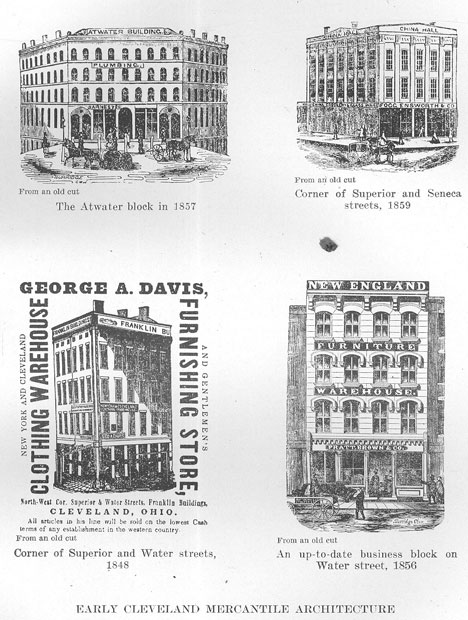
HISTORY OF CLEVELAND - 617
were erected on the river. After the severe panic of 1837 the town began to take on new activity. In September, 1843, the "Herald" gives a picture of this growth. Within two years one hundred and fifty buildings had been built, a fine row of brick dwellings on St. Clair street built by George Worthington and Isaac Taylor "with iron railings, cut stone steps and neat courts." Captain Levi Johnson built his fine cut stone mansion corner of Water and Lake street. This was torn down in 1909. The stone was brought from Kingston, Canada, "at six dollars per toise of two hundred and sixteen feet." The old Mansion House on Superior street and Vineyard lane was torn down and two blocks of stores built for Atwater of New York ; the rooms were rented at once. The third floor contained a "Music Hall" of "double the capacity of any in the city." This "Atwater Block" was the leading business block of its day. In 1844-45 two hundred and twenty-six buildings were erected." There was no speculation in lots and no vacant houses were to be had. In 1845-6 the new buildings included one hundred and forty-six houses, thirty stores, fifteen machine shops, two offices, the New England hotel and several factories.* This growth increased from year to year. It was the normal development of a healthy commercial town. In 1853 approximately seven hundred and thirty-three thousand dollars was invested in new buildings,17 mostly on Water, Superior and Merwin streets.
At this period the plain three and four story "blocks" still standing on lower Superior street, were built, also many fine residences. Captain Johnson's house alluded to above, was a good type of the sedate mansions built on Lake street. Walnut and Chestnut streets had many fine homes and St. Clair and Wood streets, indeed all the level tableland between Superior and the lake was considered available for the finest homes. Euclid became fashionable a little later. In 1849 Henry B. Payne built his mansion on Euclid street. It was considered "princely." Henry Gaylord built below Erie, the same year. The town was noted for its beautiful location. In the '40s and '50s multitudes of fine elms, oaks and maples were planted to make Cleveland "the Forest City." Even in its village days, travelers remarked upon its beauty. In 1840 Howe wrote : "It is one of the most beautiful towns in the Union and much taste is displayed in the private dwellings and the disposition of shrubbery." 18 The mercantile architecture did not keep pace with the domestic architecture. It was often said that "Cleveland's residences are the finest, its business architecture the shabbiest in the United States."" Only within the last decade are the mercantile buildings taking rank with the finest in the country.
COST OF LIVING
In 1833 John Stair from London, England, wrote a letter which describes so graphically the conditions of that period that it is reproduced here in entirety.
16 - "Herald," April 2, 1845.
* - "Herald," September 24, 1845.
17 - "Herald," October 18, 1853.
18 - "Historical Collection," Vol. 1, P. 498.
19 - "Leader," February 17, 1869.
618 -HISTORY OF CLEVELAND
"County Cuyahoga, Ohio.
Newburg, August 16, 1833.
My dear Thomas :-
"The opportunity affords for sending a few lines by `Cheapside' which I gladly embrace. You have thought it strange perhaps that I have not written you before but when I tell you that on every letter we send to England we have to pay 25 cents postage to New York and 27 cents for every one we receive (if brought by private hand and posted at New York, 25 cents), added to which the uncommon scarcity of money, you will cease to be surprised. Frequently men who are possessed of a good farm and considerable stock are weeks and months without a.cenC. They barter, or as they call it, trade, for almost everything, and are so accustomed to it that they don't feel it, but it is particularly trying to foreigners who have not the means to do so, consequently their resources are soon drained, unless they have sufficient to purchase a farm where by hard work they may soon supply nearly all their wants. Many raise all they eat with few exceptions, such as tea, coffee, etc. They raise their own wool and flax which are spun and woven by the women for clothing, so that a farmer is the most independent person in this country, and any person with a small income may live well for one-third that they can in England.
"Before I give you the prices of a few things, I should tell you that our accounts are kept by dollars (market thus $) and cents. A dollar is equal to eight shillings York, or one hundred cents. For large Turkeys, 5o cents each; fowls one shilling, or 12 1/2 cents each; roasting pigs, 25 cents each ; mutton, beef, pork, veal, etc., 4 cents per pound; when bought by the quarter, 2@2 1/2 cents per pound ; butter, from nine cents to one shilling per pound; cheese, six cents per pound; groceries with the exception of tea, as dear as in England; Young Hyson, $1.00 per pound; cows, from $10 to $25 each ; horses, from $30 to $100 each ; clothing of all kinds is dear. So you see, this is the poor man's country, but unless he has land or can labor hard, a man with a family of small children stands but a poor chance. Situations for single men are very scarce except as bartenders at taverns, clerks, etc. Shopmen are little better off in the old country with little more than their board and lodging.
"New York is quite overdone, so many stop there. We arrived there the 1st of September just as the cholera began to abate. Its ravages there, and, indeed, nearly all over the States, were very great. We were mercifully preserved all the way, although at several times lodging under the same roof with it, but without knowing it at the time. There were cases in every town we passed through. It has again broken out in the Southern States, and I expect will reach Cleveland, six miles from us, it being a place where so many emigrants land. It is a very increasing place, and for the size of it, the prettiest town I have seen in America. Its situation on the lake is so commanding that it will soon be a place of great importance, and the inhabitants are beginning to have a taste for the fine arts, so that a person who understood drawing, music, etc., so as to teach it well, might make money apace there. Mechanics of all description meet with employment.
"Education in this country is conducted very differently to what it is in the old country. Each state is divided into townships of five miles square. Each
HISTORY OF CLEVELAND - 619
township is again divided into districts and each district has a schoolhouse. These are called district schools and are taught by a female in the summer and by a man in the winter. The former is paid about $6 per month and boards around at the houses of the different pupils, a week at each place. The male teacher gets from $10 to $20 per month, according to the size of the school, and boards around. In many places they have select or private schools. I have kept one here. * * * We are exceedingly tried for want of cash. I have taken but little more than $5 in cash for education since I have been in the country-a little more than a sovereign (they fetch $4.75).” (20)
In 1838 flour was seven dollars and fifty cents the barrel, potatoes one dollar the bushel, good beef twelve and one-half cents per pound, pork the same. These were hard times prices and very high for "Cheap Ohio."
In 1840 flour was taken in lieu of New York exchange at three dollars and fifty cents the barrel. In June the papers give prices as follows : Cheese, four and one-half cents per pound; butter, nine cents; eggs, five cents per dozen; oats, thirty-seven to forty cents per bushel ; dried apples, one dollar per bushel; sugar, seven and one-half cents per pound; Rio coffee, seven and one-half cents to eight and one-half cents per pound; spring steel, six cents per pound ; nails, assorted, six cents per pound ; sheet iron, six and one-fourth to seven and one- half cents; sheetings, seven and eight cents per yard; blue shirtings, eight and one-half to ten and one-half cents per yard ; prints, eight and one-half to sixteen cents per yard ; and forty-two to seventy cents per yard. (21)
On March 29, 1843, mechanics and workmen met to protest against the "present practice of paying mechanics and laboring men in orders and store pay." They resolved "that so long as money is the circulating medium of this country, it alone is the proper pay for the services of every class of the community." The men did not complain of low wages, because they said the times were hard, but they did want money, and declared that after April 5 they would not take anything else in payment. On April 5 they held a large mass meeting in the Square, preceded by a workingman's parade. The protest was only partially successful. (22)
In 1848 ( January 11), the papers give wholesale market quotations as follows: Flour, five dollars to five dollars and fifty cents the barrel; wheat, one dollar per bushel ; corn, forty cents per bushel ; oats, twenty-five and thirty cents per bushel; hogs, two dollars and fifty cents to three dollars twelve and one- half cents per hundred weight; lard, seven cents the pound; white fish, seven dollars the barrel; trout, six dollars, and pickerel five dollars; hams, four cents; beef, twelve cents the pound; apples, thirty-seven to sixty-two cents the bushel; sugar, New Orleans, six and one-fourth cents ; loaf sugar, ten and one-half to eleven and one-half cents; eggs, fourteen cents per dozen; table butter, eleven to twelve cents. In July, 1848, cheese was six cents; butter, nine and one-half cents; eggs, ten cents; and pork, six dollars and twenty-five cents the barrel.
20 - "Annals Early Settlers Association," No. 4, P. 40.
21 - From the Market Quotations.
22 - See "Weekly Plain Dealer."
620 - HISTORY OF CLEVELAND
The following schedule is given to show what the yearly expenses of a fine
retail store on Superior street were in 1853:
